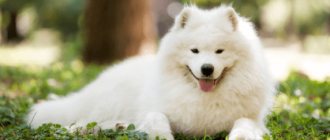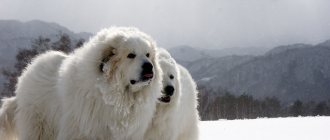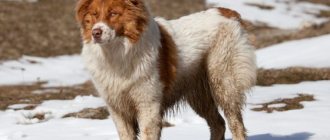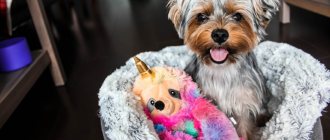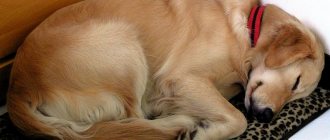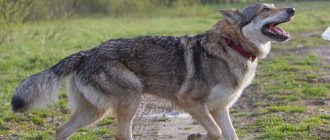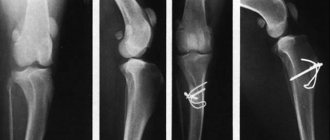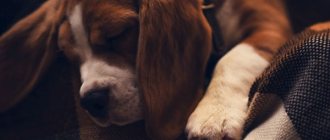a brief description of
- Other names: Sicilian Hound, Cirneco dell'Etna, Sicilian Greyhound, Sicilian Greyhound, Sicilian.
- Height: 46.0-50.0 cm.
- Weight: 10-12 kg.
- Color: red, even, rich. Let's say white and white with red tan. All shades of fawn and all shades of ocher are allowed.
- Coat: short, no longer than 3.0 cm, smooth, lying close to the body.
- Life expectancy: 12-15 years.
- Advantages of the breed: easy to train, unpretentious dogs. They have an affectionate and affectionate character. Their temperaments are typical hunters. The family has cheerful, loving and very active dogs, right up to old age.
- Difficulties: hard to tolerate cold, and especially dampness. Dogs need to be warmed in winter. The animal's claws require careful attention and should be trimmed promptly.
- Price: $950.
Description
The Cirneco dell'Etna is similar to other Mediterranean greyhounds, such as the Pharaoh Hound, but smaller. These are medium-sized dogs, graceful and elegant.
Males at the withers reach 46–52 cm and weigh 10–12 kg, females 42–50 and 8–10 kg. Like most greyhounds, she is very thin, but does not look emaciated like the same Azawakh.
The head is narrow, 80% of its length is the muzzle, the stop is very smooth.
The nose is large, square, its color depends on the color of the coat.
The eyes are very small, ocher or gray in color, not brown or dark hazel.
The ears are very large, especially in length. Standing, rigid, they are triangular in shape with narrow tips.
The Cirneco dell'Etna's coat is very short, especially on the head, ears and paws. On the body and tail it is slightly longer and reaches 2.5 cm. It is straight, hard, reminiscent of horse hair.
Cirneco del Etna is almost always the same color - fawn. White markings on the head, chest, tip of the tail, paws and belly are acceptable, but may not be present. Sometimes dogs are born completely white or white with red spots. They are acceptable, but not particularly encouraged.
Origin story
The first information about the existence of elegant dogs with the musical-sounding name Cirneco dell'Etna was recorded as a result of archaeological excavations in the area at the foot of the Sicilian volcano Etna. Hence the prefix to the name of the breed.
According to scientists, the breed dates back at least two and a half thousand years , and belongs to the aboriginal dogs of the island of Sicily. According to recent research, which was based on genetic analysis, animals in Sicily appeared thanks to the ancient Egyptians, who developed the surrounding territories.
Scientists have noticed that the images of animals on the sarcophagi and tombs of the ancient Egyptian pharaohs are very similar to the modern phenotype of these dogs - beautiful and elegant with long, gracefully upward-pointing ears.
Even the Egyptian god of the underworld, Anubis, has similarities with the features of the pointy-eared Sicilian greyhound. Therefore, we can safely make the assumption that the age of the breed is much older than official information is presented to us.
Other Italian dogs that are close to this phenotype are the Pharaoh Hound and the Ibicenco Podenco, which are just as elegant and evenly colored, but differ from the Cirneco dell’Etna in a much larger size. It can be assumed that all of the above Italian dogs had common ancestors.
History of the origin of the breed
There is a legend according to which 1000 of these dogs were guards and watchmen of a religious structure dedicated to the spirit of the Adranos volcano, which was built by ancient people on one of the slopes of Etna. People believed that Cirnecos could distinguish an honest person from a thief and an unbeliever.
Researchers of the breed talk about its impressive age, which exceeds 2500 years. Genetic analyzes confirm that dogs appeared before the birth of Christ. Among the close relatives of the Cirneco, the Pharaoh Hound is noted, but other Mediterranean dogs also participated in the formation of the breed.
The origin of the breed occurred in the sunny Sicilian lands, near Mount Etna. And thanks to the isolation of the island, its formation took place in natural conditions, without human intervention or the influence of other breeds.
The modest size of these greyhounds is associated with the fact that the island did not have an abundance of food. However, their small size does not prevent the Cirneco dell'Etna from being excellent hunters, capable of catching a rabbit or other small game.
Purpose of the breed
There are two unofficial modern varieties of the Sicilian Greyhound breed:
- southern type;
- type of northern Cirneco dell'Etna.
Both types differ in body proportions and different lengths of limbs. But this factor was not reflected in the description of the breed standard adopted by the FCI. Leg length no small importance only for dogs working in the Sicilian landscape - mountainous in the north and flat rocky in the south of the country and at the foot of a volcano. Greyhounds are still used for their intended purpose. They participate in traditional rabbit hunting.
Over the past fifty years, animals have been bred exclusively for sporting competitions. Also, field trials are often held for breeding dogs, where the Cirneco dell'Etna can show itself in all its glory.
The third purpose of the modern Sicilian is a companion dog. Obedient, intelligent, extremely sensual dogs often become prize-winners in dog shows held around the world. Sicilian greyhounds also take part in coursing competitions, or simulated hare-catching races, and agility.
Cirneco del Etna - living companions of the departed pharaohs
The proud Silician dog breed has ancient roots going back 2.5 thousand years. On ancient coins of the period III-V centuries BC. and mosaics of the era depict the profile of Cirneco. Through genetic analysis, the relationship between modern individuals and pharaoh dogs has been proven.
Purpose of the breed
There are two unofficial modern varieties of the Sicilian Greyhound breed:
- southern type;
- type of northern Cirneco dell'Etna.
Both types differ in body proportions and different lengths of limbs. But this factor was not reflected in the description of the breed standard adopted by the FCI. Leg length no small importance only for dogs working in the Sicilian landscape - mountainous in the north and flat rocky in the south of the country and at the foot of a volcano. Greyhounds are still used for their intended purpose. They participate in traditional rabbit hunting.
Over the past fifty years, animals have been bred exclusively for sporting competitions. Also, field trials are often held for breeding dogs, where the Cirneco dell'Etna can show itself in all its glory.
The third purpose of the modern Sicilian is a companion dog. Obedient, intelligent, extremely sensual dogs often become prize-winners in dog shows held around the world. Sicilian greyhounds also take part in coursing competitions, or simulated hare-catching races, and agility.
Advantages and disadvantages
Cirneco is a dog breed that has a fairly extensive list of advantageous features, thanks to which it is so valued in its homeland:
- unpretentious pets;
- curious and easy to learn;
- have an affectionate and affectionate character;
- typical hunter's temper;
- active and inquisitive until old age, so they need to devote a lot of time.
Another significant advantage is that dogs do not have an undercoat, therefore, the animals have no odor and the likelihood of developing an allergic reaction in household members is very small.
Despite a number of advantages, there are also disadvantages:
- hind toes dewclaws;
- short dewlap and neck;
- short muzzle;
- divergence of the muzzle and skull.
Dogs can be touchy at times. If the owner has offended his pet, the latter may stop obeying and carry out even the most primitive commands.
Character
Sicilian greyhounds are considered unsurpassed hunters. Their energetic temperament is surprisingly combined with peacefulness and complaisance . In general, the Cirneco del Etna can be described as a playful, affectionate, cheerful breed with a very affectionate and devoted character.
The animal is distinguished by its inquisitiveness and immense curiosity. A priori, they have no sense of dominance, since dogs do not lead a pack lifestyle.
They are wary of strangers, but get along well with animals. If training is directed in the right direction, the Sicilian Greyhound will make a good guard and an intelligent watchman.
Representatives of this breed do not like to be intrusive and rarely speak out . These are great companion dogs. They are happy to accompany their owners on trips, long walks or bike rides, proudly walking alongside them, as they are very hardy dogs.
Maintenance and care
Cirneco is sensitive to cold , so it is better to make the bed higher so that drafts walking along the floor do not harm the dog. Warm clothing is required in winter and autumn .
This breed requires long active walks , preferably with active games. In the absence of exercise, they can gain weight, as they have an excellent appetite. It’s better to walk her on a leash so she doesn’t run away.
Coat care is very simple: once a week, comb out dead hairs with a soft brush. The ears should be inspected and cleaned as needed, as Cirnecos are prone to inflammation and ear infections.
Cirneco has an extremely negative attitude towards claw trimming and desperately resists it, so it is better to accustom them to this procedure as early as possible. The second option: walk the dog longer so that the nails wear down naturally.
Choosing a puppy
According to the unspoken but generally accepted rules for choosing a puppy, you should adhere to the basic principle. Of all the strong, active and playful puppies in the litter, you should choose the average one , not the large one, or vice versa, the quietest and smallest dog child.
The puppy should not have any signs of rickets. If the stomach is swollen and it is not rickets, you should ask when the puppies were last dewormed, and immediately deworm them upon arrival home.
At two months, puppies look the same as they will look as adults. At eight weeks you can see a miniature copy of an adult dog . Therefore, it is highly desirable to have a visual acquaintance with the parents of the litter, where you can carefully examine both the mother and the father of the glorious family.
The puppy you have chosen must have the following documents:
- birth certificate certified by the breed club;
- veterinary passport, which contains the dates of vaccinations, according to the age of the baby;
- an implanted chip or brand, or possibly both;
- pedigrees of mother and father;
- parental health certificates.
As a rule, the breeder provides detailed recommendations on raising and feeding the puppy in writing, and leaves his contact details so that the new owner can contact him without delay in emergency or unusual cases.
Nicknames and names
All pedigree puppies have nicknames, and their new owners assign pet names to them. Names do not appear in breeding records, and are used by the owner at the everyday level.
Popular nicknames for dogs of the Sicilian Greyhound breed are, as a rule, Italian concepts and definitions, as well as geographical names of places:
- males - Are, Lyman, Wacker, Hesper, Kato, Vaiden, Borat;
- females – Nelda, Lima, Nicey, Jassy, Verity, Brigita, Dixa, Bessie.
Care and maintenance
The Sicilian Greyhound is quite unpretentious in its maintenance. It is enough to comb it once a week with a special brush with stiff bristles. These are very clean animals, and also odorless. Dogs are bathed extremely rarely - even for those who participate in exhibitions, bathing with special means is provided no more than once a month.
The ears of the Cirneco dell'Etna require a lot of attention. Dogs should have their ears cleaned regularly, as accumulated secretions can cause inflammation of the middle ear. The dog's nails need even more attention and need to be trimmed regularly. Animals of the light weight category do not wear them down well during a walk, and the length of the claws is of particular importance in the life of the dog, especially in puppyhood. Long claws not only lead to changes in gait, but also cause improper formation of the joints of the limbs during the growth and development of the dog.
Sicilians do not tolerate dampness well and absolutely do not tolerate rainy weather. They swim happily, but the water dripping from above puts them in a depressed state.
Animals are afraid of dampness, frost and drafts. Therefore, a place is arranged for them in the warmest corner of the house. After an hour or an hour and a half, if the dog was walked in pouring rain or on a frosty day, it should measure its body temperature to avoid colds in the pet.
Care and training
The Cirneco dell'Etna breed is good for keeping in an apartment, as well as in a country house, but not on the street. Dogs are low maintenance. They need periodic combing of their fur; you can use a special rubber mitten. Despite the lack of undercoat, they still shed.
It is not often necessary to bathe the dog; this is done as needed (2-3 times a year). In addition, the owner must keep the dog’s teeth clean (clean once a week) and promptly trim its nails, which, despite walks, are poorly worn down due to the dog’s light weight. It is also necessary to clean your ears as they become dirty.
Walking is important for the Cirneco. The dog is active and cheerful, it needs to give out its energy, otherwise it can turn the whole house upside down. It is necessary to walk with the cirneco for several hours a day. Both walking and, for example, accompanying the owner riding a bicycle are possible.
Cirneco can be fed both natural food and dry food, but natural feeding is preferable. Natural food for the Cirneco means eating a lot of raw meat (the basis of the diet) with the addition of grains, vegetables and fruits. Dry food is acceptable. For owners, it is easier and more convenient to use ready-made food; you just need to take the choice seriously; it is preferable to super-premium or holistic food.
The Cirneco dell'Etna has a high level of intelligence and is very trainable. To do this, it is better to choose positive stimulation methods. Owners need to take into account this peculiarity - Cirneco is very sensitive to odors and can easily get distracted and follow the scent, in which case it will be almost impossible to recall it. Therefore, you should always keep your dog on a leash while walking.
Health and heredity
Veterinarians classify this ancient Sicilian breed as one of the healthiest representatives of the canine world. Moreover, dogs do not suffer from heredity or predisposition to certain diseases.
No breed diseases have been found in Sicilian greyhounds at all.
But dogs need seasonal treatments against blood-sucking parasites - fleas, mosquitoes and ticks, carriers of severe infectious diseases. Preventive measures are also necessary to expel worms from the digestive tract. Not only pets, but also their owners need regular deworming.
Character and training
The character of Cirneco del Etna is described in very two ways. On the one hand, these four-legged animals are very independent and have developed willpower, on the other hand, dogs are very affectionate to people and suffer from a lack of communication. The advantage of the breed is a very flexible and stable nervous system, which allows the Cirneco del Etna to adapt to the owner’s lifestyle and his needs.
READ Domestic fox or fennec fox at home
Representatives of the breed are very active and energetic, but they must live in an apartment. Here the future owner must decide whether he is ready to radically change his life for the next 15 years? It is better to play with Cirneco del Etna on the street, believe me, it is in your interests. At the same time, four-legged animals are not characterized by a love for long walks; they prefer to fool around a little and return to a warm lounger.
Cirneco del Etna is equally loved by all family members, but the owner is singled out. This point becomes obvious when the dog reaches 1.5–2 years of age. At approximately the same age, strong instincts for protecting the territory will make themselves known. I am glad that the Sicilian Greyhound does not like to make noise and bark for no reason, but if the dog is fussing, there are reasons for this.
Dogs are very affectionate to their owners and should not be left without their owner for long. The Sicilian Greyhound is an ideal dog for owners who lead an active lifestyle and play sports.
If you do not yet have a family and children, it is worth considering that the jealousy of Cirneco del Etna applies to everyone, regardless of age. There are no guarantees that the dog will treat the child well or badly. It all depends on the degree of socialization, temperament and lifestyle of the four-legged animal.
The Sicilian Greyhound is absolutely not suitable for beginners who have no experience in training temperamental dogs. During training, the owner will have to be tough, but it is important not to overreact or intimidate the dog, not to humiliate it, or to ruin self-esteem. With such strong-willed animals, this balance is very difficult to achieve.
Education and training
As soon as the puppy has crossed the threshold of a new home, you should start raising it, immediately socialize it, and train it independently. The dog should be introduced to every dog he meets, a neighbor, an acquaintance, and people he simply meets by chance. In the absence of proper upbringing, a timid neurasthenic may grow up, aggressive towards his relatives, and hopelessly afraid of strangers.
Advantages and disadvantages
Dogs of the Cirneco dell'Etna breed are extremely intelligent. The exterior shows the unsurpassed harmony of these graceful dogs with the appearance of an emperor. Animals are obedient and accommodating. Moreover, they are very insightful and, as they say, see right through the owner, always guessing the owner's desire.
Dogs do not have an undercoat, so the animals have no odor and are considered hypoallergenic dogs. And secondly, they have difficulty withstanding the cold season unless they are dressed in a blanket, jacket or special sweater.
Dogs of this breed are not suitable for every owner. A beautiful and spectacular animal is far from a glamor model. These dogs are contraindicated for people leading a sedentary lifestyle. While still a puppy, breeders recommend not accustoming the dog to a diaper or litter box, so that the dog gets used to going to the toilet outside from the first days.
Among all the Mediterranean dog breeds, the Sicilian Greyhound has amazing abilities and is easy to train. On the other hand, dogs are capricious and have their own opinions. Sometimes they become disobedient, refusing to carry out even the most primitive commands of the owner. And this can only happen because the dog was treated unfairly or was offended in some way.
Description of the nature of the breed
The Sicilian Greyhound is an excellent hunter, but at the same time it is curious. She has an independent and strong character, but is always ready to make contact.
These animals have a stable psyche and are great with children, but it is still not recommended to leave this dog alone with a child, as they are quite jealous of their owners.
This breed loves active games and company, and is also an exclusively domestic pet. Cirneco del Etna can easily get along in the same territory with another dog or cat, but on the street it can start hunting unfamiliar animals.
If this breed lives in an apartment, then it is better to completely abandon rodents (hamsters, guinea pigs) in the same area.
Reviews
Valery:
Our pet is only three months old, but he is a born athlete. Not once did he lag behind me on a bike ride. He always runs alongside and can keep the pace for a long time, and this is at three months! Passionately loves fruits, and most of all apples.
Lena:
This breed was created for me, with my restless character. And it’s good that I took the boy. True, I had to suffer a little with his upbringing, but now he is just a calm and surprisingly obedient dog, who will not take a step without my order.
We invite everyone who has had at least a little contact with this amazing ancient breed of dog - the Cirneco dell'Etna - to dialogue. Tell us about your experience with these animals. What are their advantages and what disadvantages could become an obstacle to purchasing a puppy of this breed. We look forward to your comments and feedback. They can be left at the bottom of the article.
Share
Leave a review
History of the origin of the Sicilian Greyhound
The Sicilian Greyhound or, as it is called more pathetically and sonorously, the Cirneco Dell'Etna, is one of those few dog breeds that have not just an ancient, but simply a multi-thousand-year history of existence.
A global study conducted by European scientists as part of the study of canine species in the Mediterranean has established that the unique greyhound dogs that have lived in Sicily since time immemorial are descendants of ancient hunting dogs, in turn brought by the Phoenicians from Egypt.
However, the Italians, and especially the native Sicilians, do not agree with these conclusions; they are still convinced that their magnificent greyhounds are exclusively indigenous dogs of Sicily, which independently bred over centuries (or millennia - the Italians happily agree with this) in the vicinity of the Etna volcano.
However, real facts convince us otherwise. Modern Cirneco dogs really have the closest resemblance in appearance and color to the ancient Egyptian pointy-eared dogs depicted on the funerary sarcophagi of the pharaohs, as well as on the surviving bas-reliefs and frescoes of the pyramids, which are more than one thousand years old.
Many sculptural compositions of ancient Egyptian dogs have also been preserved, practically no different from modern breeds: the Pharaoh Hound and the Cirneco Dell'Etna greyhound. Well, if you look at this whole story even more closely, you will find an incredible similarity between modern Sicilian greyhounds and the god of the underworld of Ancient Egypt, Inpu (aka Anubis), as you know, who was depicted by the Egyptians with the head of a pointy-eared jackal.
The mass of artifacts discovered by archaeologists very clearly indicates the ancient origin of Cirneco dogs, the roots of which go back many millennia into the history of Ancient Egypt, no matter how much Sicilian dog handlers opposed it.
Yes, and in Sicily itself, much evidence has been found of the extraordinary antiquity of the Sicilian Cirneco family. Many ancient coins of archaic eras with greyhound dogs minted on them, numerous frescoes and engravings preserved from time immemorial depicting hunting scenes with pointy-eared slender dogs are the best confirmation of this.
The first, closer to us in time, documentary mention of the real existence of Cirneco greyhounds in Sicily appeared in the book “De Natura et solertia canum” published in 1653 in Palermo by the Italian naturalist-researcher Andrea Cirino. Subsequently, the encyclopedia “Sistema Naturae” by Carl Von Linne was also published, where an entire chapter was dedicated to the wonder dogs from Sicily.
After these publications, Sicilian greyhounds disappear from the field of view of scientists for a long time. They are remembered again only in the first half of the 19th century. In the published article “Fauna Etnea” (“Fauna of Etna”), the author G. Galvagni gave not only a detailed description of the canids living near the Etna volcano, but also proposed his hypothesis of their appearance in Sicily, and also made a modest attempt to give the first scientific name to the species - Canis Etneus ("dog of Etna"). However, this publication was not continued. Canis Etneus was again forgotten for a long time.
Despite the fact that Cirneco greyhounds were distributed throughout Sicily and were one of the favorite dog breeds of local rabbit hunters for centuries, these agile dogs would remain a familiar but unremarkable animal, little known to the rest of the world. Stupid selection carried out by local Sicilian peasants, interested only in the working qualities of the dog in exterminating rabbits that spoil their harvest (to the detriment of the beauty of the unique exterior) rapidly brought the ancient breed closer to complete degeneration.
And so it would have been if in 1934 an energetic and selflessly in love with the breed ascetic, the Sicilian Baroness Agata Paterno Castello, had not taken up the matter. Being an ardent supporter of the development of the aboriginal greyhound, she, by all means, decided to announce it to the world.
Having made the decision to revive the species, Baroness Castello energetically and actively, like a true Sicilian, began a scientifically based, full-fledged selection of signature hunting dogs of Sicily, searching for and selecting for her only the best individuals available on the island. Her work (carefully documented and described as much as possible in her diaries) was generally completed by 1939.
In the same year, the first breeding standard for ancient dogs was officially approved, written by Donna Agatha (Baroness Castello) in collaboration with the famous Italian zoologist Professor Giuseppe Solaro. The breed first received an official name - “Cirneco Dell'Etna” and was included in the Stud Book of the Italian Kennel Club (ENCI).
Further selection and plans of the baroness were prevented by the outbreak of World War II, which brought famine and devastation to Italy, causing serious damage to the greyhound population of Sicily. During the war years, Donna Agata managed with great difficulty to preserve her kennel Cirneco Dell'Etna, which at that time contained about eight dozen greyhounds of unique beauty.
Only in 1947 were the Baroness and her associates able to seriously begin to restore and further develop Cirneco. In 1951, the Cirneco Dell'Etna fan club was founded, and already in 1952, a greyhound named Aetnensis Pupa became the first Italian champion.
In 1958, Baroness Castello died of skin cancer (at the age of 44), having devoted 26 years of her life to the revival of the greyhounds of Sicily. With her death, the breed again fell into oblivion, and the animals that fell into the wrong hands again found themselves on the verge of degeneration.
The new revival of the breed was undertaken by veterinarian Francisco Scaldara, who managed to obtain several breeding specimens from the Baroness’s nursery. He managed to revive the variety, obtaining graceful and elegant dogs that fully comply with the standard (his pets received a prefix to their name - “Taorminensis”). It was from his Cirneco that the further species development of the breed began (including foreign branches).
Nowadays, many breeders are engaged in the selection and development of Cirneco Dell'Etna, both in Italy and in other countries of the world (USA, UK, Russia). In 1989, the breed received full international recognition with registration with the FCI.

